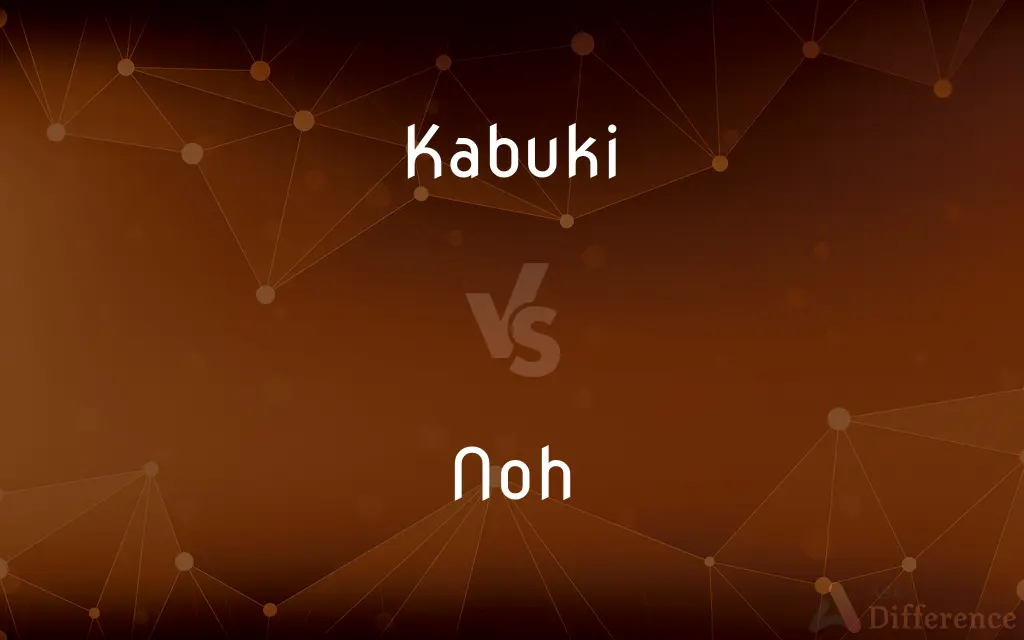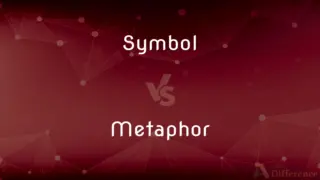Kabuki vs. Noh — What's the Difference?
Edited by Tayyaba Rehman — By Fiza Rafique — Updated on September 22, 2023
Kabuki is a traditional Japanese theater form that focuses on melodrama, spectacular dance, and elaborate costumes. Noh is a form of classical Japanese musical drama that prioritizes symbolism, minimalism, and philosophical depth.

Difference Between Kabuki and Noh
Table of Contents
ADVERTISEMENT
Key Differences
Kabuki is a form of Japanese theater characterized by its melodramatic style and elaborate costumes. It often features exaggerated movements, colorful scenery, and contemporary stories. Kabuki aims for showiness and mass appeal, making it accessible to a broader audience.
Noh, on the other hand, is a much older form of Japanese theater that revolves around traditional stories and involves highly stylized performances. It relies heavily on masks, symbolic gestures, and a slow, deliberate pace to convey its often-philosophical themes. Noh is more minimalistic and nuanced, requiring a particular level of understanding and cultural literacy to fully appreciate it.
Kabuki frequently incorporates elements of song and dance and uses a broad range of musical instruments. Its stage is technically elaborate, featuring mechanisms like revolving platforms. Noh uses traditional instruments, and its stage is simplistic, usually containing just a painted pine tree at the back.
In Kabuki, both male and female roles may be played by male actors, and the emphasis is often on the visual spectacle. In Noh, the cast is also predominantly male, but the focus is on symbolic storytelling, and the roles require deep internalization of character.
While both Kabuki and Noh are quintessentially Japanese art forms, Kabuki tends to be more popular and accessible, especially among tourists. Noh appeals to a smaller, more specialized audience interested in the ritualistic and symbolic aspects of Japanese culture
ADVERTISEMENT
Comparison Chart
Style
Melodramatic, lively
Minimalistic, austere
Themes
Contemporary
Traditional, symbolic
Stage
Technically elaborate
Simplistic
Music
Various instruments
Traditional only
Audience Appeal
Broad, mass appeal
Specialized, niche
Compare with Definitions
Kabuki
A form of traditional Japanese theater known for melodrama.
The Kabuki performance was filled with dramatic flair.
Noh
A classical form of Japanese musical drama.
Noh is considered one of Japan's oldest theatrical forms.
Kabuki
Characterized by elaborate costumes and makeup.
The Kabuki actors wore intricate costumes.
Noh
Characterized by its use of masks and slow pacing.
The Noh performance was a meditative experience.
Kabuki
Uses a technically elaborate stage.
The Kabuki stage had revolving platforms and trap doors.
Noh
Focuses on symbolism and philosophical themes.
Noh plays often explore complex human emotions.
Kabuki
Features exaggerated movements and emotions.
The Kabuki play was a feast for the eyes.
Noh
Utilizes traditional Japanese instruments.
The music in Noh is haunting and traditional.
Kabuki
Popular and accessible, especially among tourists.
Kabuki is often recommended for first-time visitors to Japan.
Noh
Has a simplistic stage setting, usually with a painted pine tree.
The Noh stage design was austere but deeply symbolic.
Kabuki
Kabuki (歌舞伎) is a classical form of Japanese dance-drama. Kabuki theatre is known for its heavily-stylised performances, the often-glamorous costumes worn by performers, and for the elaborate kumadori make-up worn by some of its performers.
Noh
Noh (能, Nō, derived from the Sino-Japanese word for "skill" or "talent") is a major form of classical Japanese dance-drama that has been performed since the 14th century. Developed by Kan'ami and his son Zeami, it is the oldest major theatre art that is still regularly performed today.
Kabuki
A type of popular Japanese drama, evolved from the older Noh theater, in which elaborately costumed performers, nowadays men only, use stylized movements, dances, and songs in order to enact tragedies and comedies.
Noh
The classical drama of Japan, with music and dance performed in a highly stylized manner by elaborately dressed performers on an almost bare stage.
Kabuki
A form of Japanese theatre in which elaborately costumed male performers use stylized movements, dances, and songs in order to enact tragedies and comedies.
Noh
A form of classical Japanese music drama.
Kabuki
A stylized, pretentious, and often hollow performance; especially political posturing.
Common Curiosities
How is Kabuki performed?
With exaggerated movements, colorful costumes, and a technically elaborate stage.
What is Noh?
Noh is a form of classical Japanese musical drama with a focus on symbolism and philosophical themes.
Is Noh popular among tourists?
Not as much; it's generally more appealing to those interested in traditional Japanese culture.
How is Noh performed?
With stylized movements, masks, and a minimalistic stage.
Do Noh performances feature music?
Yes, but only traditional Japanese instruments are used.
Is Kabuki only in Japan?
While rooted in Japan, Kabuki has gained international popularity.
What kinds of stories do Kabuki plays tell?
They often tell contemporary or historical stories with emotional depth.
What kinds of stories do Noh plays tell?
They usually tell traditional stories filled with symbolism.
What is Kabuki?
Kabuki is a traditional Japanese theater form known for its melodramatic style and elaborate costumes.
Who performs Kabuki?
Mainly male actors, although some females have started to enter the field.
Which is older, Kabuki or Noh?
Noh is older, dating back to the 14th century, whereas Kabuki originated in the 17th century.
Is Kabuki popular among tourists?
Yes, it's accessible and often recommended for first-time visitors to Japan.
Do Kabuki performances feature music?
Yes, they often include song and dance with a range of musical instruments.
Who performs Noh?
Predominantly male actors trained in the traditional style.
Is Noh only in Japan?
Noh is mainly performed in Japan but has also been staged abroad in specialized settings.
Share Your Discovery

Previous Comparison
Symbol vs. Metaphor
Next Comparison
Preschool vs. NurseryAuthor Spotlight
Written by
Fiza RafiqueFiza Rafique is a skilled content writer at AskDifference.com, where she meticulously refines and enhances written pieces. Drawing from her vast editorial expertise, Fiza ensures clarity, accuracy, and precision in every article. Passionate about language, she continually seeks to elevate the quality of content for readers worldwide.
Edited by
Tayyaba RehmanTayyaba Rehman is a distinguished writer, currently serving as a primary contributor to askdifference.com. As a researcher in semantics and etymology, Tayyaba's passion for the complexity of languages and their distinctions has found a perfect home on the platform. Tayyaba delves into the intricacies of language, distinguishing between commonly confused words and phrases, thereby providing clarity for readers worldwide.













































